 W
WAetobatus laticeps, the Pacific white-spotted eagle ray, is a species of cartilaginous fish in the eagle ray family Myliobatidae. It is found in the tropical East Pacific Ocean, ranging from Baja California to northern Peru, including the Galápagos. Until 2014, it was included in the similar spotted eagle ray, but the two differ in genetics. Following the split, A. narinari is restricted to the Atlantic, while the Indo-Pacific is inhabited by the closely related A. ocellatus.
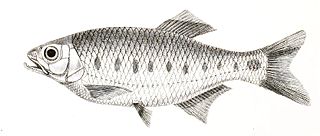 W
WBarilius bakeri is a fish in genus Barilius of the family Cyprinidae. It is found in Kerala of India.
 W
WThe bat ray is an eagle ray found in muddy or sandy sloughs, estuaries and bays, kelp beds and rocky-bottomed shoreline in the eastern Pacific Ocean, between the Oregon coast and the Gulf of California. It is also found in the area around the Galápagos Islands. The largest specimens can grow to a wingspan of 1.8 m and a mass of 91 kg (201 lb). They more typically range from 9.07–13.61 kg (20.0–30.0 lb). The size of the bat gray is dependent on many factors, such as habitat alterations, different oceanographic and environmental conditions. The sexual maturity size of the female Myliobatis california is often greater than the male one. Bat rays are euryhaline, i.e. they are able to live in environments with a wide range of salinities.
 W
WThe blackchin shiner is an abundant North American species of freshwater fish from the family Cyprinidae. Described by Edward Drinker Cope in 1865, it is not a well-known species. It is a close relative of the blacknose shiner. Chiefly occurring now in the Great Lakes and occasionally in upper Mississippi River drainages, the blackchin once ranged commonly as far south as Illinois and Ohio. This fish resides over sandy bottoms in cool waters that provide a lot of cover for the small minnow. Omnivorous, it eats worms and small arthropods as well as plant material. Blackchin shiners are unique because of their anatomical features, such as the black coloring, the incomplete lateral line, and a distinctive dental arrangement.
 W
WLabidesthes sicculus, also known as the Brook silverside is a North American species of Neotropical silverside. The brook silverside lives in slow moving rivers and lakes from the Great Lakes to the Mississippi Basin and Gulf Coastal Plains. The brook silverside survives best in clear water with aquatic vegetation. L. sicculus feeds on a diet of copepods, insect larvae, and winged insects. The spawning season of the brook silverside occurs during the spring and early summer. The survival of freshwater fishes such as the brook silverside is increasingly threatened. In order to ensure survival of the brook silverside, turbidity of natural habitats should be monitored.
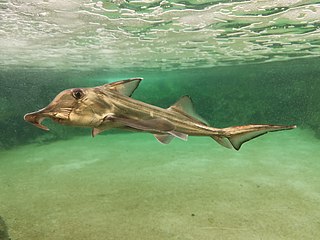 W
WThe Cape elephantfish, josef, or St Joseph shark is a species of fish in the family Callorhinchidae.
 W
WThe Malabar snakehead is a vulnerable species of snakehead from freshwater in the Western Ghats in India. Until 2011, it was usually included in the giant snakehead, C. micropeltes.
 W
WThe Chinese high-fin banded shark is a popular freshwater aquarium fish that belongs to the family Catostomidae. It grows to about 1.35 m long and is unsuitable for most home aquariums.
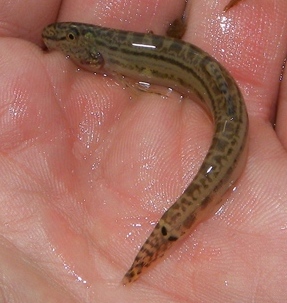 W
WCobitis bilineata is a species of ray-finned fish in the family Cobitidae found in Croatia, Italy, Slovenia, and Switzerland. Its natural habitats are intermittent rivers and freshwater marshes. It is not considered threatened by the IUCN.
 W
WThe Denison barb, Denison's barb, Miss Kerala, red-line torpedo barb, or roseline shark is an endangered species of cyprinid fish endemic to the fast-flowing hill streams and rivers of the Western Ghats in India. It is commonly seen in the aquarium trade; pet collection caused it to become endangered and is its single major threat.
 W
WThe double-lined fusilier is a fusilier of the genus Pterocaesio. Also known as the banana fish, it is the prefectural fish of Okinawa, Japan, where it is known as gurukun (グルクン) in Okinawan and takasago in Japanese.
 W
WThe greenstripe barb, silver barb or striped barb is a tropical freshwater and brackish fish belonging to the subfamily Cyprininae of the family Cyprinidae. It originates in inland waters in Asia, and is found in Pakistan, India, and Sri Lanka.
 W
WHaludaria melanampyx is a species of cyprinid fish endemic to India where it is known from south Kanara through the Travancore hills to the Nagercoil, Nilgiris, and Cauvery drainages in the Western Ghats, India.
 W
WThe leafy seadragon or Glauert's seadragon, Phycodurus eques, is a marine fish in the family Syngnathidae, which includes seadragons, pipefish, and seahorses. It is the only member of the genus Phycodurus.
 W
WMesonoemacheilus triangularis or Nemacheilus periyarensis is a species of stone loach endemic to the Western Ghats in southern Karnataka, Kerala, and Tamil Nadu, India. It is a fairly common species occurring in streams with gravel, cobbles and bedrock with some sand as the substrate. This fish grows to a length of 5.8 centimetres (2.3 in) SL and can be found in the aquarium trade.
 W
WThe mimic shiner is a species of North American cyprinid freshwater fish in the genus Notropis. The genus Notropis is commonly known as the eastern shiners. It is native to areas of the Hudson Bay drainage, Great Lakes drainage, much of the Mississippi River basin including areas of Tennessee, Virginia, North Carolina, and regions of the Gulf of Mexico extending from Mobile Bay to the drainage of Texas. However, this particular species can be found in other places such as the Atlantic Coast drainage in Connecticut and Housatonic rivers. This genus is usually characterized by almost all having a complete lateral line, 8 dorsal fin rays, a premaxillae protactile, and a silvery or speckled peritoneum. As the common name indicates, this species is difficult to classify in the wild because it looks similar to many other shiners. In fact, some even hypothesize that this species is actually a complexity of many cryptic species. While this is the case, it is important to take more caution to not misidentify this species and to understand its impact on introduced areas.
 W
WThe painted goby is a small goby of Western European waters from Trondheim Fjord to Spain, the Canary Islands and is sometimes reported in the Mediterranean Sea. Also mentioned in the Black Sea. It lives at depths from 1 to 55 metres, preferring a gravelly or sandy environment. Its young may sometimes be found in tide pools. It feeds on amphipods and copepods.
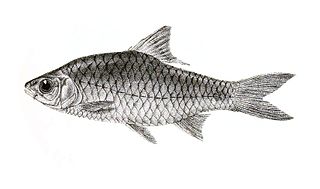 W
WThe Parrah barb is a species of ray-finned fish in the genus Puntius. It is found in Kerala, Karnataka and Tamil Nadu in India.
 W
WPethia punctata is a species of cyprinid fish found in streams and ponds of the Western Ghats of India. There have also been unconfirmed reports that it is also present in Sri Lanka. This species can reach a length of 7.5 centimetres (3.0 in) TL.
 W
WPotamotrygon magdalenae, the Magdalena River stingray, is a species of freshwater fish in the family Potamotrygonidae. It is found only in the Magdalena and Atrato basins in Colombia, but it is locally abundant and among the predominant fish species in its range. It is a small species of stingray with a typical disc width of about 20 cm (8 in), although it can reach up to 35 cm (14 in).
 W
WPuntioplites proctozystron, Smith's Barb or Pla Mang is a species of ray-finned fish in the genus Puntioplites.
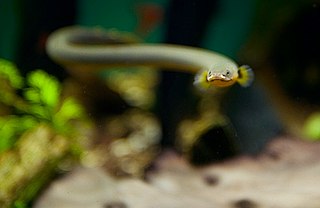 W
WThe reedfish, ropefish, or snakefish, Erpetoichthys calabaricus, is a species of freshwater fish in the bichir family and order. It is the only member of the genus Erpetoichthys. It is native to West and Central Africa. The reedfish possesses a pair of lungs in addition to gills, allowing it to survive in very oxygen-poor water. It is threatened by habitat loss through palm oil plantations, other agriculture, deforestation, and urban development.
 W
WSalvelinus killinensis, also known as Haddy charr is a variety of charr found in certain lakes in Scotland.
 W
WThe scaled sardine, Harengula jaguana, is a herring-like fish in the family Clupeidae. It is native to coastal waters of the western Atlantic Ocean, from the Gulf of Mexico down to Brazil where it is called mata.
 W
WThe sand shiner is a widespread North American species of freshwater fish in the family Cyprinidae. Sand shiners live in open clear water streams with sandy bottoms where they feed in schools on aquatic and terrestrial insects, bottom ooze and diatoms.
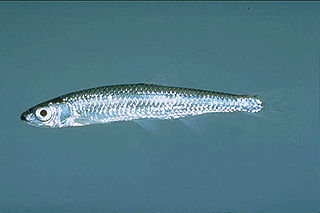 W
WThe silver shiner is a species of ray-finned fish in the genus Notropis. It is found in the United States and Canada where it inhabits much of the Ohio River basin south to northern Georgia in the Tennessee River drainage. It also found in western Lake Erie tributaries and the Grand River system in Ontario. Though visually very similar to the emerald shiner, which occupies a similar range, it can be distinguished by the presence of two dark crescents between its nostrils, on the top of the head.
 W
WThe silver sweep, also known as the false pompano, sweep, trumps or windawindawi, is a species of marine ray-finned fish from the subfamily Scorpidinae of the sea chub family Kyphosidae. It is native to the southwestern Pacific Ocean from Australia to New Zealand.
 W
WSilverjaw minnows are part of the family Cyprinidae, which includes carps and minnows. With over 300 known species, there are more species of minnows native to North America's fresh waters than any other fish. Minnows can be hard to distinguish because many look alike. All minnows have one dorsal fin, ventral fins near the anus, a lateral line system, and smooth, round cycloid scales. Their jaws lack teeth, but they have one to three rows of pharyngeal teeth to grind food. Defining physical characteristics such as the number and type of fin rays, type of scales, and pattern of pharyngeal teeth are used to distinguish minnows.
 W
WThe swallowtail shiner is a North American species of freshwater fish in the family Cyprinidae. It has a slender and long body of about 40–55 mm. The shiner has a pale yellow back with a blue stripe on its silver side. It also has a silvery white belly. Its fins are yellowish and it has a dorsal fin originating above the back half of the pelvic fin base and a tail fin with a black spot at its base. Its snout is either slightly pointed or slightly rounded. The swallowtail shiner lives in warm creeks and in river pools. It is known to live in Virginia in the New River system and near the Atlantic slope. It is often found near plants. The shiner eats insects, worms, mites, microcrustaceans, and algae. Juvenile shiners mature after a year and spawn from mid-May to July when the water reaches a temperature of 25.6 °C. Fecundity is unknown in this species and it breeds well in aquariums. It is similar to the closely related Cape Fear shiner and sand shiner.
 W
WSynodontis guttatus is a species of upside-down catfish that is native to the Niger River basin of Nigeria. It was first described by German ichthyologist Albert Günther in 1865, from the Niger River. The species name guttatus is the Latin word for "spotted", referring to the spots appearing on the fins and body of the fish.
 W
WThe plains topminnow is a species of freshwater topminnow found in North America. The fish has a small range within the United States of America which consists of two major populations.
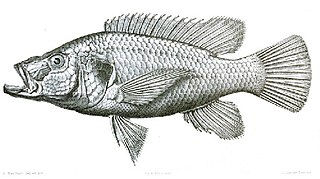 W
WTristramella sacra, the long jaw tristramella, is a species of cichlid fish that was endemic to the Sea of Galilee in Israel. It has not been recorded since 1990, despite searches both of the lake and in local markets, and it is regarded as extinct by the IUCN. This species could reach a total length of up to 28 cm (11 in).
 W
WYasuhikotakia modesta is a tropical freshwater fish of the family Botiidae. It is native to large rivers in Thailand, Laos, Cambodia, and Vietnam. The blue botia is a widely available fish in the aquarium trade and can be purchased globally.